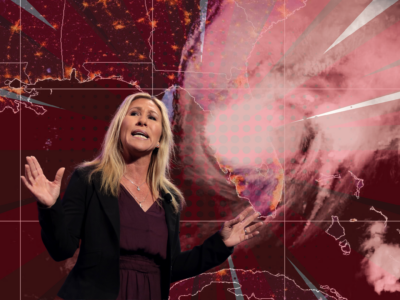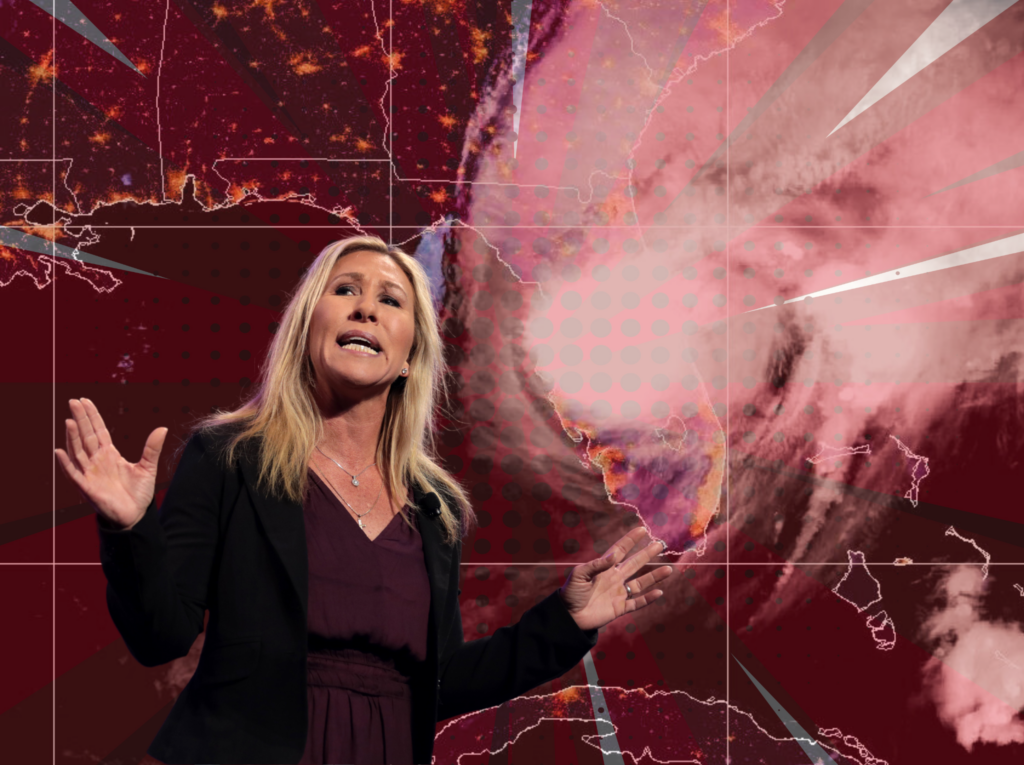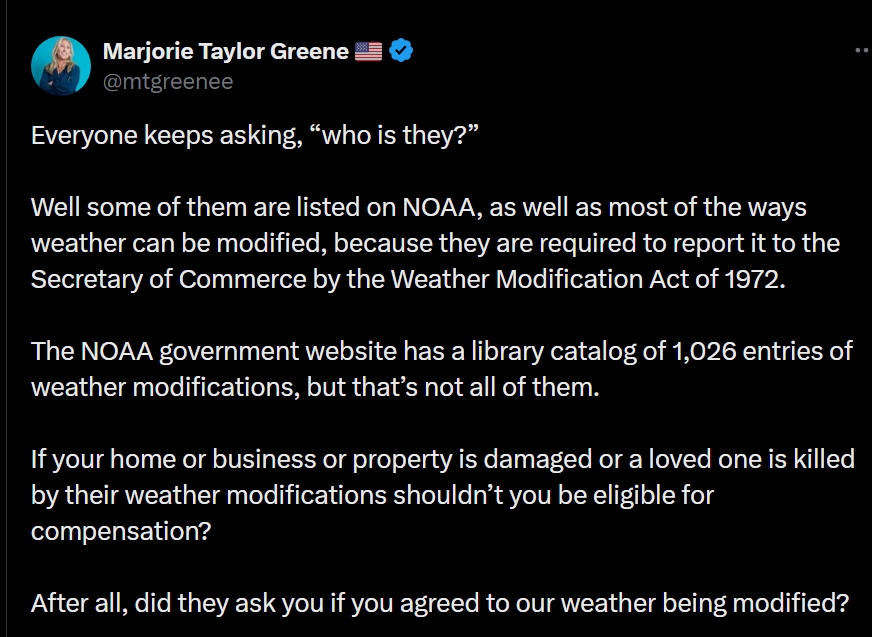Reflections on “Yes they can control the weather.”
Legal Planet: Environmental Law and Policy 2024-10-17


Since U.S. Rep. Marjorie Taylor Greene tweeted earlier this month that “Yes they can control the weather” — a bunch of commentators have pointed out that she’s wildly wrong. Yes, she’s wildly wrong. No one can make, intensify, or steer hurricanes. No ability to do anything like this is even on the horizon. Her comment obviously got traction because it plugged into a deep strain of populist paranoia, including active, current conspiracies.
But it’s also worth noting that it’s easy for her to spread error and confusion on this point, because there are a few things somewhat similar to what she’s saying that are real — one about current capability and practice, one about historical speculation and worry, and one about potential future capability being discussed. These things make her false claims even more damaging and irresponsible, because they speak to an area where people can be legitimately confused.
First, weather modification practice and capabilities as they actually exist. People sometimes try to manipulate certain bits of the weather, sometimes successfully. Weather modification by cloud seeding has been a big commercial activity since the 1940s, practiced in the United States and two dozen other countries. This consists of spraying tiny particles into clouds, either shooting them up from the ground or dropping them from airplanes, to nudge water vapor that is cold enough to form raindrops but hasn’t yet done so (this is called supercooled water vapor). People do cloud seeding to increase rain or influence where it falls, to reduce destructive hailstorms, and to make clear skies. In a fun historical note, one person involved in early cloud-seeding research was Bernard Vonnegut, a scientist at General Electric’s research lab in Schenectady New York. Bernard’s younger brother Kurt was very interested in his work and enjoyed visiting the lab. You may have heard of him.
For decades, no one could tell whether this worked — given the variability of weather, it’s really hard to tell — and the field had a ton of hype and over-claiming. Lately both the methods and the testing have been getting better, and it’s becoming increasingly clear that cloud seeding can be moderately effective under the right conditions.
But it’s small stuff. The basic spatial scale of intervention is individual clouds. Even at this tiny scale, there is a US federal requirement to report any weather-modification activity, under a 1972 Statute administered by NOAA. (That is what MTG was referring to in the tweet below.) It is possible to expand the scale of effort to target many clouds — which requires lots of airplanes or lots of cannons — but it remains the case that only some clouds under some conditions are suitable. By far the most ambitious activities and the most expansive claims are in China, where weather modification schemes came to international attention when they were used to clear the skies over Beijing for the 2008 Olympics. (More here, here, and here)

The second sort-of real thing that MTG’s statements plugged into is the much grander ambition, and the associated apocalyptic fears, that marked the early days of weather modification. Weather modification practice emerged in parallel with enormous advances in weather science, models, and forecasting in the 1950s and 1960s, especially with the development of computerized weather-forecasting models. Prominent people at the time — including John Von Neumann, one of the leading scientists of the 20th century and the sort-of inventor (there wasn’t just one) of both the computer and game theory — speculated that people might gain near-complete control of the weather, and warned that hostile weather control could be a threat to peace and human survival as grave as that posed by nuclear weapons.
At that time there were also a few attempts to do much larger-scale weather modification than the small-bore cloud-seeding capabilities that were more extensively practiced. The US military, infamously, used cloud-seeding on large scale (although not nearly as large as now practiced domestically within China) in an effort to extend the monsoon season and obstruct military transport by the Viet Cong, in “Operation Popeye.” Together with the parallel US use of toxic defoliants, this provoked sufficient international outrage to lead to the adoption of the international treaty on environmental modification, or ENMOD, in 1977. ENMOD prohibited large-scale environmental modification activities for “military or other hostile purposes,” while also explicitly exempting, even encouraging, international cooperation in environmental modification for peaceful purposes.
There were also a couple of projects that did try to control hurricanes – but failed. “Project Cirrus,” a joint project of the US military and General Electric researchers, tried to disrupt and weaken one 1947 hurricane by seeding its eyewall clouds to increase rainout and destabilize its structure. They chose a hurricane that looked to be headed safely out to sea and dropped 80 kilograms of dry ice near its eye. Given later advances in understanding hurricanes, this was a laughably tiny intervention — truly spitting into a gale. Hurricanes are unpredictable, however, and shortly after the attempted intervention this one took a sharp left turn and made landfall near Savannah, GA (MGT’s state). The project had not been widely publicized, but rumors and leaks led to angry protests and lawsuits. It took more than a decade for the operators to come clean and admit they had made the intervention — the attempt, not that it did anything, which it clearly did not.
There were still enthusiastic proponents, however. And you’ve got to have some sympathy for the effort. Looking at current loss of life and other damages, it would surely be a good thing if it were possible (and reliable and safe) to control hurricanes and reduce their damage. Proponents made two other small hurricane-seeding attempts, in Hurricane Daisy in 1958 and Esther in 1961, neither of which had any significant effects. A project established in 1962, named “Stormfury,” tried to be more careful in its choice of hurricanes to mess with. This policy had the consequence that very few storms met the criteria, yet the project still yielded a mix of inconclusive results and outright failures. In one especially comedic episode, the researchers cancelled a plan to seed Hurricane Betsy in 1965 — but were still blamed for the significant damage Betsy did when it came ashore. The project made its last flight in 1971 but stayed on the books another decade, until it was quietly abolished in 1983.
The upshot is that actually exercising any control over hurricanes would be a task light-years bigger than that small-scale control of local weather that is actually practiced. From the 1940s until about 1970 a few people thought it was possible and secured the resources to try a few times. But it never worked, the efforts in retrospect seem ludicrous, and they were quietly abandoned. This history also gives a couple of related lessons—that there are, and probably will continue to be, things that some people claim others are doing that wildly exceed what is actually possible — witness MTG statements. Closely related, even talking about doing something like changing the weather can expose you to charges that you’re responsible for any damage the weather does – even if you didn’t actually do anything.
Which brings me to the third source of confusion related to MTG’s statements. People now really are discussing the possibility of making intentional interventions to change the climate — or rather, to reduce some of the climate disruptions that are happening and coming due to human elevated greenhouse gases.

Two caveats are in order. First, the interventions people are talking about would influence the climate, not the weather. They’re not the same. Weather is what’s happening today. It changes all the time, by a lot. Climate is average weather — the conditions you expect at a given place in a given season, which define the statistical envelope around the conditions you get but is not the same. Modeling and predicting the climate is a lot more feasible than doing the same for the weather. Second, no one is doing anything like these proposed interventions now. In fact, they are barely being researched. There are significant political movements aligned around rejecting researching and discussing these interventions, let alone doing them. There are also conspiracy theories — which MTG plugs into — that say someone is already doing something like these interventions, for nefarious purposes and with harmful effects. This cluster of beliefs is generally called “chemtrails” (from the belief that the white lines of condensed water vapor or ice behind jet airplanes are not, in fact, water or ice, but are “chemicals”). Like many conspiracy theories, this one is initially amusing — Wait, who do they think is doing this, what exactly are they doing, and why? To make us all docile? To addict us to genetically modified food? Any my favorite, it’s a feminist plot to feminize the men. Just look at how testosterone levels and sperm counts are plummeting, not to mention those hermaphrodite frogs. The amusement only lasts a little while, though, after which the fact that so many people believe this just becomes dreary and depressing.
The climate interventions that are being discussed would nudge the whole climate system — temporarily and imperfectly — in a slightly less destructive direction, with no possibility of local or short-term control. (I touch on this in a new paper at the Annual Review of Environment and Resources with my co-author David Keith. More on this paper in coming blog posts.) These interventions would not precisely offset greenhouse-gas-driven climate change. They could cool the Earth on average but not precisely undo the patterns of disruption from GHGs. But they are like GHG-driven climate change in that they both affect average climate conditions, not the random variation of weather that occurs within the envelope of those average conditions. If an intervention were ever done, whether or not it influenced a particular weather event (a heat wave, an intense downpour, or even an extreme season of weather in a region) would be a matter of statistical estimation, not clear causation, which — depending on the strength of the intervention — might take a decade or two to attribute.
One benefit of these interventions projected based on models would be to reduce the intensity of the most extreme hurricanes, which greenhouse gas-driven climate change is increasing. They would achieve this by reducing the current trend of increasing sea surface temperatures. This would cut off the top end of the worst hurricanes, the ones for which all conditions come together to make them as strong as possible, so their energy is limited only by the amount of heat and water vapor available to collect from the ocean surface. But even this would be a statistical effect, reducing the intensity of those storms that would otherwise have been the most extreme, which would not be identifiable in advance.
Summing up — why it can be true both that there are reasonable grounds for people hearing statements like MTG’s to be confused, and that her statements are dishonest, dangerous nonsense.
Small-scale weather modification is a routine activity, in the US and elsewhere, and it’s starting to look like it can be moderately effective at increasing rainfall or changing precisely where and when it falls in some regions where conditions are favorable. Decades ago, a few people thought it was possible to exert stronger control over weather, including breaking up hurricanes or influencing their direction, and there were some experimental attempts to do so — but they all failed, and the efforts were abandoned.
Now, people are talking about possible interventions that might limit or delay some of the most harmful effects of global climate change. These effects would be temporary and imperfect, so would only be stopgaps that might buy time to achieve the vast energy and economic transformations needed to reduce greenhouse gas emissions. If these interventions were ever used, one of their likely effects would be to slow or reduce the increase in the destructiveness of the most extreme hurricanes that is occurring due to climate change. But all of this is a vast distance away from saying that people are able to exercise meaningful control over hurricanes, certainly not to change the intensity or direction of individual storms.
Who knows, maybe in 50 years people will figure out how to steer or weaken hurricanes, or even prevent their formation. After all, it is generally not a good idea to bet against extreme progress in technological capabilities, certainly not over decades.
But no such capability exists now. The possibility is so remote as to be implausible. Suggesting otherwise — let alone that someone might have been able to, and wanted to, direct current hurricanes onto particular places in some bizarre act of political aggression — is both wild fantasy and wildly irresponsible dishonesty.